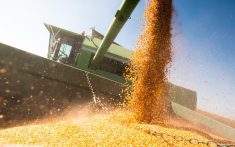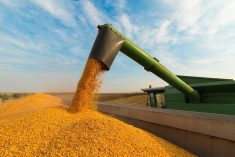Chicago | Reuters—Chicago soybeans and corn slumped on low demand and a stronger dollar on Tuesday as financial markets recovered from an epic sell-off on Monday.
Wheat futures rose after a massive tender from Egypt for 3.8 million metric tons to cover imports between October 2024 and April 2025—its largest ever according to traders.
Also supportive was a forecast from commodity data specialist Argus Media, that this year’s soft wheat crop in France is expected to shrink to its lowest level in 41 years after heavy rain slashed both the crop area and yields.
Read Also

U.S. grains: Chicago grains firm as traders gauge China purchases
Chicago | Reuters – Chicago soybean futures ticked up on Wednesday as traders eyed Chinese purchases of U.S. beans under…
The most active soybean contract on the Chicago Board of Trade (CBOT) Sv1 settled down 14 cents at $10.26-3/4 a bushel, halting a two-session bounce.
CBOT corn Cv1 fell 2 cents to $4.05 a bushel and CBOT wheat Wv1 rose 3-3/4 cents to $5.43-1/4 a bushel.
Low global oilseed demand weighed on soybean prices, according to Karl Setzer, co-founder of Consus Ag Consulting.
China is buying little and not sourcing much from the U.S., said Setzer. He said less than a third of Chinese soybean demand is coming to the U.S. despite competitive prices.
“That tells us that our demand just isn’t there right now.”
Corn and wheat swung back and forth after largely holding up during Monday’s sell-off in other markets, as funds covered already large short positions and an export-friendly drop in the dollar lent support, traders said.
But on Tuesday, a firming dollar made U.S. exports less competitive, and the focus shifted to the U.S. Department of Agriculture’s monthly supply and demand report, to be released Aug. 12.
“Trade is getting a little anxious,” Setzer said, with some analysts predicting a reduction in acres and others seeing yields remaining high.
“We’re just seeing that fight back and forth a little bit,” he said.
—Additional reporting for Reuters by Gus Trompiz in Paris and Naveen Thukral in Singapore















